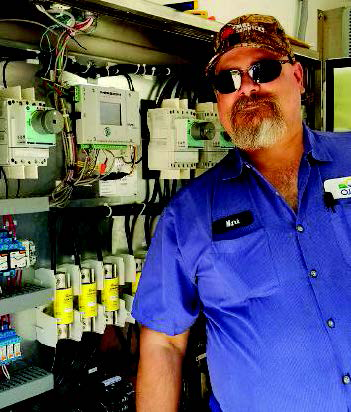

In the heart of Oconee County, South Carolina, the Oconee Joint Regional Sewer Authority (OJRSA) plays a vital role in transporting and treating wastewater for the cities of Seneca, Westminster, and Wahalla. While each city manages its own collection systems, OJRSA ensures that wastewater flows efficiently from trunk lines to the treatment facility using a combination of pump stations and gravity sewer.
The treatment facility is rated for 7.8 million gallons per day, though current flow averages closer to 3 million gallons—a shift attributed to the departure of the textile industry over a decade ago.
A Smarter Approach to Utility Operations
For Mark Dain, Maintenance Supervisor at OJRSA, overseeing pump stations and the treatment plant requires precision, responsiveness, and reliable data. Mission Communications’ managed SCADA system has become an essential part of his toolkit, helping him:
- Monitor pump runtimes, wet well levels, rainfall, and flow data
- Issue maintenance jobs and manage tools and parts
- Quote contracts and evaluate team performance
One standout feature is the automated flow report emailed weekly. This report supports billing for serviced towns based on pulse flow values, while analog flow data is used for comparative and graphical analysis.
Purpose-Built for Water and Wastewater Utilities
Before adopting Mission, OJRSA relied on a system originally designed for generator monitoring. It lacked the responsiveness and configurability needed for wastewater operations. Reporting intervals were slow, analog inputs were difficult to configure, and the web portal was not user-friendly.
“Our director didn’t like the way the portal was formatted for the previous system. After using Mission, I can see why,” said Dain. “It didn’t have graphs, and it wasn’t as interactive. You couldn’t customize reports like you can on the Mission portal.” Mission’s system is designed specifically for water and wastewater utilities, offering intuitive tools, real-time alarms, and flexible reporting that make operations smoother and more transparent.
Solving Problems Before They Escalate
Mission’s system has helped OJRSA uncover hidden issues and improve operational workflows:
- Rain Event Monitoring: During heavy rainfall, a blind spot in the flume’s level sensor caused dead band, preventing accurate flow measurement. Mission’s system now detects these events, allowing recalculation and accurate billing.
- Pump Efficiency Tracking: Foreign objects can cause pumps to become “ragged,” reducing efficiency. Mission’s variance reports and daily summaries help Dain spot these trends quickly, even when off-site. “It’s almost like it grabs stuff without you having to go look for it,” he said.
- Generator Fuel Monitoring: Using ultrasonic sensors, OJRSA now tracks fuel levels remotely—critical during severe weather. This eliminates manual checks and reduces exposure to fuel and water contamination. “If you don’t have that, someone has to go out in the rain and put a stick in the tank,” Dain explained. “You’re getting water in the fuel, and you’re getting fuel on you.”
- Signal Rerouting During Construction: When part of the facility was under construction, operators rerouted sensor signals to Mission units, maintaining visibility and control from a central location.
Reliable Data, Real-Time Insights
Mission Communications continues to support OJRSA with tools that are not only reliable but also adaptable to the evolving needs of utility operations. From flow monitoring to generator fuel tracking, the system empowers teams to respond faster, work smarter, and make data-driven decisions.
Learn More About Mission’s Managed SCADA Solutions
Mission Communications offers scalable, intuitive solutions for water and wastewater utilities.